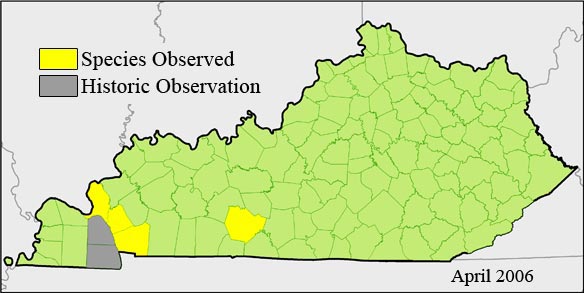P�h�o�t�o� �b�y� �K�S�N�P�C� �S�t�a�f�f�
|
Habitat:
Rocky limestone open wooded slopes and floodplain edges among mixed hardwoods.
|
Species Description:
Plant a herbaceous, twining, perennial vine, to 5 m, scrambling over other vegetation, arising from a large, starchy underground tuber. Leaves alternate, 0.6-1 foot long, composed of 5-9 (mostly 7) ovate leaflets; the lowest pair of leaflets usually the largest. The flowers are swollen, greenish-pink with maroon tints and a beak-like tip. They are arranged in compact racemes, on stout hairy stalks. Fruit an elongated legume, 5-8 inches long, somewhat swollen, abruptly narrowing into a slender beak. The seeds are oblong, smooth, dark brown, and about 0.3 inch long.
|
Phenology:
Flowering Period: Early July to mid August.
Fruiting Period: Early August to late September.
|
Additional Information at NatureServe
|
Diagnostic Characteristics:
This species most closely resembles Apios americana (= A. tuberosa), from which it is distinguished by the following characteristics: (a) larger leaves, usually with 7 rather than 5 leaflets; (b) the uppermost petal (standard) has an elongated tip, is larger, and is pink with green tints rather than maroon; (c) the fruits are longer, the shortest ones similar in length to the longest ones in A. americana. Wisteria is similar, but can have more leaflets (5-11) which are all about the same size and widest in the middle (in contrast to those of Apios); the leaf rachis of Wisteria is hairy, and its flowers are purple and bloom in the early spring.
|
Management:
Avoid creating access to the site through trail or road construction. Timber removal may be beneficial . Hand removal of trees in the vicinity is needed to maintain the open character of the habitat for this species.Disturbance of surrounding slopes such as ATV trails or timber removal or any activity that results in increased erosion will be detrimental. Exotic pest plants are a threat to this species.
|
Global Range:
Mississippi (Clay, Oktibbeha and Lee counties); Alabama (Madison, Autsuga and Marshall counties); Kentucky (Lyon, Livingston and Trigg counties); Tennessee (Marion, Montgomery and Williamson counties).
|
Known Kentucky Occurrences:

|